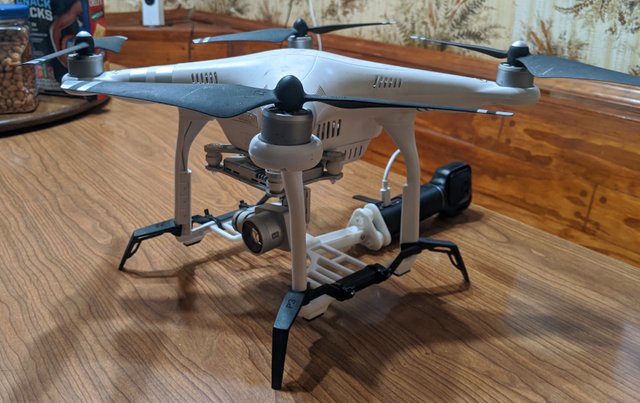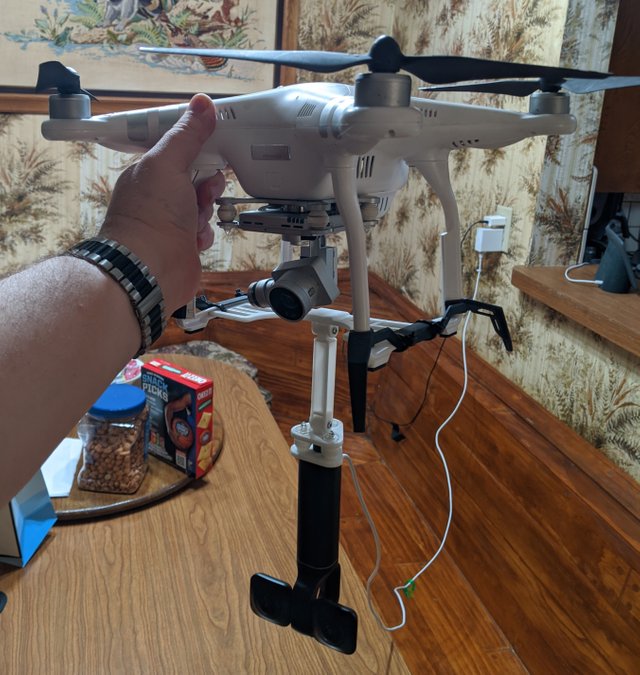VR180 3D Footage from DJI Drone
.jpg)
Today in the waning light of day
I captured some airborne VR180 3D footage from my quadcopter at Temple City park. The video is available on Facebook for viewing with or without a VR headset. Stabilization has worked on this clip pretty well but I couldn't avoid some jerky navigation because of the winds. So be advised that if you're prone to motion sickness there are a few spots that might get to you. Enjoy the viewing of this experimental camera mount.
How this video was achieved.

Pictured is my DJI Phantom 3 with a custom 3D printed camera mount (no longer available on Amazon), extended landing gear Amazon link and a Vuze XR 360/VR180 camera slung behind. Amazon link The lenses are in opposing position for 360 degree recording prior to launch to avoid scratching the lenses on the launch surface.

After launch the Vuze XR can hang beneath the quadcopter. In this position the dual lenses can be deployed to face forward for stereo VR180 recording.
As pictured you can see that the Vuze XR camera is on a small isolation shock mount. The mount has a screw which fits the standard tripod/mount threads in the base of the Vuze XR. That's right. The base of the Vuze is facing upward so during flight the video being recorded is upside down. Thankfully there is a simple toggle in the Vuze VR Studio software to flip the video right side up which manages the left/right stereo recordings appropriately.
This configuration worked pretty well all told. Unfortunately there were some pretty strong winds during this flight and it resulted in some unwanted wobble of the Vuze XR. In software I was able to apply a stabilization which smooths out all but the worst of the camera movements. Unfortunately a horizon stabilization was not able to be applied since it produces some strange results when the camera footage is upside down. I guess this is a problem with interpreting the camera's IMU data by the Vuze VR Studio. At a later date I'm going to see if I can get better results using After Effects to do a precision stabilization. For now these results are good enough.
Some concerns going in.
This setup is geared to isolate the Vuze XR camera from the drone's vibrations. However the drone's pivoting for maneuvering causes the dangling camera to move in unwanted ways. The simple software stabilization does keep things looking pretty good but some things like sudden stops cause the camera to pendulum beneath the drone.
It's also a problem that the camera is dangling in the turbulent rotor wash of the drone at pretty much all times. The audio from the video capture is pretty useless. in fact I will probably remove audio from any future drone mounted videos I post. My most expedient path today didn't include the removal of audio.
The camera and it's mount affect the flight characteristics of the Phantom 3. The added weight although not extreme acts as a lever upon the drone. The control just doesn't feel very precise with this system attached. The wind today contributed to the drone flying a little bit funny which only added to my concern of clipping a tree branch or something else. I'm not sure what can be done about this in the future other than to fly when it's not windy.
The Vuze XR records at a fantastically high resolution of 5.7K. However I have noticed that there is an inherent softness to objects beyond 10 or 15 feet from the lenses. This is less than ideal for recording from the air. My goal today was to keep it interesting by flying close proximity to obstacles which would be in focus in the near-field. That in itself poses a problem.
.jpg)
Note the built in camera lens of the Phantom 3. The Vuze XR dangles some 14 inches below the landing skiffs of the drone.
Typically when flying the Phantom 3 using a video tap of it's built in camera I can skirt over the tops of roofs and trees no problem. Basically the camera is just about the lowest hanging part of the drone. So if you aren't running directly into something the drone is going to clear above whatever you're seeing in your video feed. With the Vuze XR attached the drone needs an additional 14 inches of clearance beneath the lens I'm seeing through. Therefore extra caution has to be exercised to ensure I don't drag the Vuze XR across objects damaging it or worse causing a crash.
Live preview from the Vuze XR would be very fun through a VR headset as it would allow the pilot to look around live from the POV of the craft. It would also afford the ability to see from the very lowest hanging part of the craft. However there are several reasons this isn't practical. For starters the Vuze XR can only send a live image through WiFi. WiFi can interfere with the transmitter (controller) of the Phantom 3 which would impact flight range and possibly cause errant behavior or even a crash. I made certain the camera's WiFi was deactivated during the flight.
Furthermore the range of WiFi is pretty short so the Vuze XR would drop it's video feed at an unsafe distance. Also the latency of the Vuze XR feed is too long to be safe for flying. There is more than a 1 second delay viewing the live feed on your mobile device.
Future plans.
Today I got a late start for a multitude of reasons. The Vuze XR thrives off of plenty of light and today's flight was perhaps an hour before sundown. Tomorrow I'll be able to fly earlier in the afternoon and expect some prettier footage. I'm also hoping for less wind. I'll work on keeping the drone docile with fewer jerky movements.
As mentioned before I'm going to experiment with stabilizing the footage in After Effects when I get a chance.
Today proved that there is potential in this camera arrangement. We'll see in the near future if I can work out the remaining kinks for a more enjoyable ride in the sky!
I am,

The Everyday Geek on Steemit